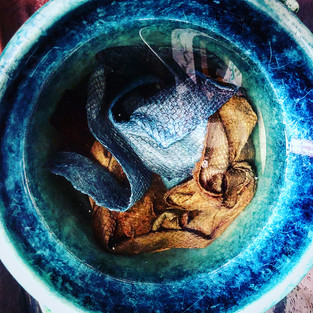Location: Hokkaido, Japan
The use of fish skin for the construction of garments is an ancient tradition shared by Arctic coastal societies, some of the earliest traces being found from the Ainu populations in Hokkaido, Japan.
The FISHSkin project has developed common interests in the UK and Japan around topics of fish skin, leather and sustainability. The project has brought together a community of experts including fashion design academics and practitioners, and artisan experts in natural dyes, with the aim of improving knowledge of sustainable methods for fish skin production as a greener alternative to exotic leather. The FISHSkin project has mapped existing traditional knowledge on natural dying from Japanese craftsmen in order to transfer the skills into fish skin.
During the trip Elisa Palomino worked with a traditional Japanese dyer at Tokushima and tested indigo dyeing on fish skin. The results were later tested on at Ars Tinctoria laboratory by Gustavo Defeo and Massimo Mancuso to evaluate the possible use in contemporary industrial dyeing for fish skin. The physical and rheological properties of the indigo and persimmon natural dye were measured for the evaluation of dye stability. The tests were found to be suitable. The samples were subjected to light and rub fastness tests and colour measurements. Colour consistency and fastness results, especially after fixation, are comparable with those on conventional leather. Fastness properties were analysed following updated ISO standards.
- May 26, 2019
Location: Rovaniemi, Finland
Participants:
University of Arts London - Elisa Palomino
Iceland University of the Arts - Katrín Káradóttir
The Cumulus conference took place at Rovaniemi, Finland as part of the Arctic and Sustainable Art and Design session.
FISHSkin researchers Elisa Palomino and Katrín Káradóttir together with Lotta Rahme (Lottas tannery, Sweden) and Joseph Boon (The Slade School of Fine Art, University College London, UK) delivered the lecture Indigenous Arctic Fish skin clothing traditions: Cultural and ecological impacts on Fashion Higher Education as part of “Around the Campfire - Resilience and Intelligence" conference.
The presentation described the fish skin workshop delivered at the world’s biggest fish skin tannery – Atlantic Leather in Iceland – where an experienced Swedish craftsperson passed down the endangered Arctic fish skin craft to the next generation of Nordic students from universities in the circumpolar area (Iceland, Denmark, Sweden, Finland) and UK, part of the sustainable fashion higher education program.
The students mapped their creative journey, explored the rich cultural background around fish skin in the Arctic and created a collection of fish skin samples with the help and guidance by the fish skin experts.
“Around the Campfire - Resilience and Intelligence" conference discussed especially the topic of resilience. What are the means, medium and methodologies of art, design and media in contributing to the adaptability and novel innovation in coping with everyday life, geographical extremes and societal challenges? How are the topics of sustainability and resilience interconnected and interwoven? The discussion is complemented by intelligence that is visible through design applications that embrace smart, green and social innovation.
Outcomes:
www.cumulusrovaniemi2019.org
- Feb 16, 2019
Location: Eilat, Israel
The FISHSkin project has been launched in February 2019 with the first consortium meeting taking place in Eilat, Israel. The interdisciplinary project team was hosted by Dr. Hanna Rosenfeld and the team of Israel Oceanographic and Limnological Research Institute (IOLR), one of our partner organizations.
It's been wonderful and exciting to meet each other for the first time, together explore the intricacies of the fish reproduction in captivity, and do a fair share of planning on the next steps as a research collective - all in the spectacular backdrop of Eilat's nature.




























